| Columbine | |
|---|---|

| |
| Aquilegia vulgaris | |
| Scientific classification | |
| Kingdom: | Plantae |
| Clade: | Tracheophytes |
| Clade: | Angiosperms |
| Clade: | Eudicots |
| Order: | Ranunculales |
| Family: | Ranunculaceae |
| Subfamily: | Thalictroideae |
| Genus: | Aquilegia L. |
| Type species | |
| Aquilegia vulgaris L. | |
| Species | |
|
130, see text | |
| Synonyms | |
|
Aquilina Bubani, nom. illeg. | |
Aquilegia (common names: granny's bonnet, columbine) is a genus of about 130 species of perennial plants that are found in meadows, woodlands, and at higher elevations throughout the Northern Hemisphere, known for the spurred petals of their flowers.
Etymology
The genus name Aquilegia comes from the Latin "Aquila", or "eagle"; this is in obvious reference to the spurred, "hook" shapes within the blooms, that many gardeners say resemble an eagle's talons.
Description
Perennial herbs, with woody, erect stock, roots forming thick rhizomes. The basal leaves are compound, 1–3 ternate, blades 3-lobed -partite, and lobes lobulate and obtuse. The cauline leaves are similar to the basal ones, while the upper ones are bract like.
The hermaphrodite (bisexual) flowers are terminal to stem and branches. They are usually pentamerous (with five spreading perianth petaloid sepal segments). Five tubular honey-leaves are semi erect with a flat limb and spurred or saccate at the base. The spur is directed backwards and secretes nectar. Stamens are numerous (often more than 50) in whorls of 5, the innermost being scarious staminodes. There are ten membranaceous intrastaminal scales. There are five pistils and the carpels are free.
The fruit has several (five to 15) follicles which are semi erect and slightly connate downwards. These hold many seeds and are formed at the end of the pistils. The nectar is mainly consumed by long-beaked birds such as hummingbirds. Almost all Aquilegia species have a ring of staminodia around the base of the stigma, which may help protect against insects. Chromosome number is x=7.
Relatives
Columbines are closely related to plants in the genera Actaea (baneberries) and Aconitum (wolfsbanes/monkshoods), which like Aquilegia produce cardiogenic toxins.
Insects
They are used as food plants by some Lepidoptera (butterfly and moth) caterpillars. These are mainly of noctuid moths – noted for feeding on many poisonous plants without harm – such as cabbage moth (Mamestra brassicae), dot moth (Melanchra persicariae) and mouse moth (Amphipyra tragopoginis). The engrailed (Ectropis crepuscularia), a geometer moth, also uses columbine as a larval food plant. The larvae of the Papaipema leucostigma also feed on columbine.
Plants in the genus Aquilegia are a major food source for Bombus hortorum, a species of bumblebee. Specifically, they have been found to forage on species of Aquilegia vulgaris in Belgium and Aquilegia chrysantha in North America and Belgium. The bees do not show any preference in color of the flowers.
Cultivation

Columbine is a hardy perennial, which propagates by seed. It will grow to a height of 40–50 cm (15–20 in). It will grow in full sun; however, it prefers growing in partial shade and well drained soil, and is able to tolerate average soils and dry soil conditions. Columbine is rated at hardiness zone 3 in the United States so does not require mulching or protection in the winter.
Large numbers of hybrids are available for the garden, since the European A. vulgaris was hybridized with other European and North American varieties. Aquilegia species are very interfertile, and will self-sow. Some varieties are short-lived so are better treated as biennials.
The British National Collection of Aquilegias was held by Mrs Carrie Thomas at Killay near Swansea. Some time during or before 2014 the collection started to succumb to Aquilegia Downy Mildew Peronospora aquilegiicola which was at the time an emerging disease to which the plants had no resistance. By 2018 the entire collection had been lost. Aquilegia can be grown from seeds or rhizomes.
Uses

The flowers of various species of columbine were consumed in moderation by Native Americans as a condiment with other fresh greens, and are reported to be very sweet, and safe if consumed in small quantities. The plant's seeds and roots, however, are highly poisonous and contain cardiogenic toxins which cause both severe gastroenteritis and heart palpitations if consumed as food. Native Americans used very small amounts of Aquilegia root as a treatment for ulcers. However, the medical use of this plant is better avoided due to its high toxicity; columbine poisonings may be fatal.
An acute toxicity test in mice has demonstrated that ethanol extract mixed with isocytisoside, the main flavonoid compound from the leaves and stems of Aquilegia vulgaris, can be classified as non-toxic, since a dose of 3000 mg/kg did not cause mortality.
Culture
The Colorado blue columbine (A. coerulea) is the official state flower of Colorado (see also Columbine, Colorado). It is also used as a symbol of the former city of Scarborough in the Canadian province of Ontario.
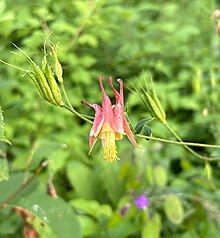
Evolution
Columbines have been important in the study of evolution. It was found that the Sierra columbine (A. pubescens) and crimson columbine (A. formosa) each has adapted specifically to a pollinator. Bees and hummingbirds are the visitors to A. formosa, while hawkmoths would only visit A. pubescens when given a choice. Such a "pollination syndrome", being due to flower color and orientation controlled by their genetics, ensures reproductive isolation and can be a cause of speciation.
Aquilegia petals show an enormous range of petal spur length diversity ranging from a centimeter to the 15 cm spurs of Aquilegia longissima. Selection from pollinator shifts is suggested to have driven these changes in nectar spur length. It was shown that this spur length diversity is achieved solely through changing cell shape, not cell number or cell size. This suggests that a simple microscopic change can result in a dramatic evolutionarily relevant morphological change.
Species

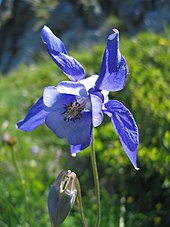
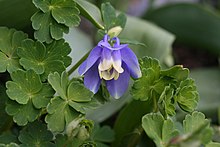
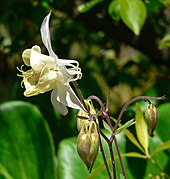

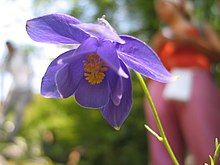

130 columbine species are accepted.
- Aquilegia alpina L. – alpine columbine
- Aquilegia amaliae Heldr. ex Boiss. - Amalia's columbine
- Aquilegia apuana (Marchetti) E.Nardi
- Aquilegia aradanica Shaulo & Erst
- Aquilegia aragonensis Willk.
- Aquilegia atrata W.D.J.Koch – dark columbine
- Aquilegia atrovinosa Popov ex Gamajun.
- Aquilegia atwoodii S.L.Welsh
- Aquilegia aurea Janka
- Aquilegia ballii (Litard. & Maire) E.Nardi
- Aquilegia baluchistanica Qureshi & Chaudhri
- Aquilegia barbaricina Arrigoni & E.Nardi – Barbaricina columbine
- Aquilegia barnebyi Munz – oil shale columbine
- Aquilegia barykinae Erst, Karakulov & Luferov
- Aquilegia bashahrica Erst
- Aquilegia bernardii Gren. & Godr. – Bernard's columbine
- Aquilegia bertolonii Schott – Bertoloni columbine
- Aquilegia blecicii Podobnik - Blečić's columbine
- Aquilegia borodinii Schischk.
- Aquilegia brevistyla Hook. – smallflower columbine
- Aquilegia buergeriana Siebold & Zucc.
- Aquilegia canadensis L. – Canadian columbine, wild columbine
- Aquilegia cazorlensis Heywood
- Aquilegia champagnatii Moraldo, E.Nardi & la Valva
- Aquilegia chaplinei Standl. ex Payson
- Aquilegia chitralensis Qureshi & Chaudhri
- Aquilegia chrysantha A.Gray – golden columbine
- Aquilegia coerulea E.James – Colorado blue columbine
- Aquilegia colchica Kem.-Nath.
- Aquilegia confusa Rota
- Aquilegia cossoniana (Maire & Sennen) Rivas Mart.
- Aquilegia × cottia Beyer
- Aquilegia cremnophila Bacch., Brullo, Congiu, Fenu, J.L.Garrido & Mattana
- Aquilegia cymosa Qureshi & Chaudhri
- Aquilegia daingolica Erst & Shaulo
- Aquilegia desertorum (M.E.Jones) Cockerell ex A.Heller – desert columbine
- Aquilegia desolaticola S.L.Welsh & N.D.Atwood – desolation columbine, Desolation Canyon columbine
- Aquilegia dichroa Freyn
- Aquilegia dinarica Beck - Dinaric columbine
- Aquilegia discolor Levier & Leresche
- Aquilegia dumeticola Jord.
- Aquilegia ecalcarata Maxim. – spurless columbine, false columbine
- Aquilegia einseleana F.W.Schultz – Einsele's columbine
- Aquilegia elegantula Greene – western red columbine
- Aquilegia × emodi Erst
- Aquilegia eximia Van Houtte ex Planch. – Van Houtte's columbine
- Aquilegia flabellata Siebold & Zucc. – fan columbine, Japanese wodamakinari (including A. akitensis)
- Aquilegia flavescens S.Watson – yellow columbine
- Aquilegia formosa Fisch. ex DC. – crimson columbine, western columbine
- Aquilegia formosa var. truncata (Fisch. & C.A.Mey.) Baker (synonym Aquilegia truncata Fisch. & C.A.Mey.) – red columbine
- Aquilegia fosteri (S.L.Welsh) S.L.Welsh
- Aquilegia fragrans Benth. – fragrant columbine
- Aquilegia ganboldii Kamelin & Gubanov
- Aquilegia gegica Jabr.-Kolak.
- Aquilegia glandulosa Fisch. ex Link. – Siberian columbine, Altai columbine
- Aquilegia gracillima Rech.f.
- Aquilegia grata Maly ex Zimmeter
- Aquilegia grubovii Erst, Luferov, Wei Wang & K.l.Xiang
- Aquilegia guarensis Losa
- Aquilegia hebeica Erst
- Aquilegia hinckleyana Munz
- Aquilegia hirsutissima Timb.-Lagr. ex Gariod
- Aquilegia hispanica (Willk.) Borbás
- Aquilegia holmgrenii S.L.Welsh & N.D.Atwood
- Aquilegia × hybrida Sims – hybrids of Aquilegia vulgaris and Aquilegia canadensis
- Aquilegia incurvata P.K.Hsiao - Qinling columbine
- Aquilegia iulia E.Nardi
- Aquilegia jonesii Parry – Jones' columbine
- Aquilegia kamelinii Erst, Shaulo & Shmakov
- Aquilegia kanawarensis Jacquem. ex Cambess.
- Aquilegia kansuensis (Brühl) Erst
- Aquilegia karatavica Mikeschin
- Aquilegia karelinii (Baker) O.Fedtsch. & B.Fedtsch. - Afghan columbine
- Aquilegia kitaibelii Schott
- Aquilegia kozakii Masam.
- Aquilegia kubanica I.M.Vassiljeva
- Aquilegia lactiflora Kar. & Kir.
- Aquilegia laramiensis A.Nelson – Laramie columbine
- Aquilegia litardierei Briq.
- Aquilegia longissima – Gray. – longspur columbine, long-spurred columbine
- Aquilegia lucensis E.Nardi
- Aquilegia magellensis F.Conti & Soldano – Magella columbine
- Aquilegia maimanica Rech.f.
- Aquilegia marcelliana E.Nardi
- Aquilegia × maruyamana Kitam.
- Aquilegia meridionalis (Quézel & Contandr.) E.Nardi
- Aquilegia micrantha Eastw. – Mancos columbine, Bluff City columbine
- Aquilegia micrantha var. grahamii (S.L.Welsh & Goodrich) N.H.Holmgren & P.K.Holmgren – Graham's columbine
- Aquilegia micrantha var. loriae (S.L.Welsh & N.D.Atwood) N.H.Holmgren & P.K.Holmgren – Lori's columbine
- Aquilegia micrantha var. micrantha
- Aquilegia microcentra Rech.f.
- Aquilegia × miniana (J.F.Macbr. & Payson) Cronk
- Aquilegia montsicciana Font Quer
- Aquilegia moorcroftiana Wall. ex Royle
- Aquilegia nevadensis Boiss. & Reut.
- Aquilegia nigricans Baumg. – Bulgarian columbine
- Aquilegia nikolicii Niketić & Cikovak
- Aquilegia nivalis (Falc. ex Brühl) J.R.Drumm. & Hutch.
- Aquilegia nugorensis Arrigoni & E.Nardi
- Aquilegia nuragica Arrigoni & E.Nardi – Nuragica columbine
- Aquilegia ochotensis Vorosch.
- Aquilegia × oenipontana A.Kern. ex Riedl
- Aquilegia olympica Boiss.
- Aquilegia ophiolithica Barberis & E.Nardi
- Aquilegia ottonis Orph. ex Boiss.
- Aquilegia oxysepala Trautv. & C.A.Mey.
- Aquilegia pancicii Degen
- Aquilegia parviflora Ledeb.
- Aquilegia paui Font Quer
- Aquilegia pubescens Coville – Sierra columbine, Coville's columbine
- Aquilegia pubiflora Wall. ex Royle
- Aquilegia pyrenaica DC. – Pyrenean columbine
- Aquilegia reuteri Boiss.
- Aquilegia rockii Munz
- Aquilegia saxifraga Casim.-Sor.Solanas & Cabezudo
- Aquilegia saximontana Rydb. – Rocky Mountain columbine
- Aquilegia scopulorum Tidestr. – blue columbine, Utah columbine
- Aquilegia shockleyi Eastw. – desert columbine
- Aquilegia sibirica Lam. – Siberian columbine
- Aquilegia sicula (Strobl) E.Nardi
- Aquilegia skinneri Hook.
- Aquilegia sternbergii Rchb.
- Aquilegia subscaposa Borbás
- Aquilegia synakensis Shaulo & Erst
- Aquilegia taygetea Orph.
- Aquilegia tianschanica Butkov
- Aquilegia transsilvanica Schur
- Aquilegia turczaninovii Kamelin & Gubanov
- Aquilegia tuvinica I.M.Vassiljeva
- Aquilegia ullepitschii Pax
- Aquilegia vicaria Nevski
- Aquilegia viridiflora Pall. – green columbine, green-flowered columbine
- Aquilegia viscosa Gouan
- Aquilegia vitalii Gamajun.
- Aquilegia vulgaris L. – common columbine, European columbine, granny's nightcap
- Aquilegia wittmanniana Steven ex Fisch., C.A.Mey. & Avé-Lall.
- Aquilegia xinjiangensis Erst
- Aquilegia yabeana Kitag.
- Aquilegia yangii Y.Luo & Lu Li
- Aquilegia zapateri Pau
See also
Notes
- In the Ranunculaceae, a variety of terms are used to describe the whorl of structures between the sepals and stamens, including honey-leaves, petals, staminodes or nectaries
References
- ^ "Aquilegia L." Plants of the World Online. Royal Botanic Gardens, Kew. Retrieved 17 May 2024.
- "Aquilegia Plants: How To Grow And Take Care Of Aquilegias". Daylilies in Australia. 28 May 2016. Retrieved 8 April 2018.
- ^ Puzey, J.R., Gerbode, S.J., Hodges, S.A., Kramer, E.M., Mahadevan, L. (2011) Evolution of Aquilegia spur length diversity through changes in cell anisotropy. Proceedings of the Royal Society B.
- "Columbine: A Flower of Meanings". San Francisco, CA: Sutro Stewards. 25 July 2017.
- Whittemore & Parfitt 2003.
- ^ Cullen et al 1993.
- ^ Mabberley 1997, p. 50.
- ^ Tamura 1993.
- Armstrong, Margaret (1915). Western Wild Flowers. New York and London: C.P. Putnam's Sons, The Knickerbocker Press. p. 134.
- Voelckel, Claudia; Borevitz, Justin O.; Kramer, Elena M.; Hodges, Scott A. (2010-03-23). "Within and between Whorls: Comparative Transcriptional Profiling of Aquilegia and Arabidopsis". PLOS ONE. 5 (3): e9735. Bibcode:2010PLoSO...5.9735V. doi:10.1371/journal.pone.0009735. ISSN 1932-6203. PMC 2843724. PMID 20352114.
- ^ Tilford (1997)
- Roberts, Jason D. (August 19, 2015). "Species Papaipema leucostigma - Columbine Borer Moth - Hodges#9478". BugGuide. Retrieved February 5, 2019.
- Macior, Lazarus Walter (1966-03-01). "Foraging Behavior of Bombus (Hymenoptera: Apidae) in Relation to Aquilegia Pollination". American Journal of Botany. 53 (3): 302–309. doi:10.2307/2439803. JSTOR 2439803.
- ^ Nold, Robert (2003). Columbines : Aquilegia, Paraquilegia, and Semiaquilegia. Portland, Oregon: Timber Press. pp. 18, 65–66, 77. ISBN 978-0-88192-588-3. Retrieved 13 January 2025.
- "The Gardener's Network".
- John Kilmer (1989). The Perennial Encyclopedia ISBN 0-88665-639-7
- Andrew McIndoe, Kevin Hobbs: Perennials. David & Charles, 2005 ISBN 1-55870-764-6 ISBN 978-1-55870-764-1
- Cullina, William (2000). New England Wild Flower Society Guide to Growing and Propagating Wildflowers of the United States and Canada. Houghton Mifflin Harcourt. ISBN 0395966094.
- "Plant Heritage - National Collections Scheme, UK Garden Plants". Nccpg.com. Retrieved 2014-05-30.
- "Touchwood Plants". Retrieved 2020-06-06.
- AM 2020.
- Dermatier, Charmaine. "Plant of the Week: Yellow Columbine (Aquilegia flavescens)". US Forest Service. United States Department of Agriculture. Retrieved 11 January 2020.
- Adamska, T (June 2003). "Hepatoprotective effect of the extract and isocytisoside from Aquilegia vulgaris". Phytother Res. 17 (6): 691–696. doi:10.1002/ptr.1233. PMID 12820244. S2CID 22144186. Retrieved 20 April 2023.
- "City of Scarborough".
- Fulton & Hodges (1999), Hodges et al. (2002)
- Whittall, Justen B.; Hodges, Scott A. (7 June 2007). "Pollinator shifts drive increasingly long nectar spurs in columbine flowers". Nature. 447 (7145): 706–709. Bibcode:2007Natur.447..706W. doi:10.1038/nature05857. PMID 17554306. S2CID 4412955.
- Dezhi, Fu; Robinson, Orbélia R. (2001). "Aquilegia Linnaeus". Flora of China. 6: 278–281.
Bibliography
- Cullen, J; et al. (1993) . "Aquilegia L.". In Tutin, T. G.; Burges, N. A.; Edmondson, J. R. (eds.). Flora Europaea. Volume 1, Psilotaceae to Platanaceae (2 ed.). Cambridge University Press. pp. 287–290. ISBN 978-0-521-41007-6. see also Flora Europaea
- Mabberley, D. J. (1997) . The Plant-Book: A Portable Dictionary of the Vascular Plants (2nd ed.). Cambridge University Press. ISBN 978-0-521-41421-0.
- Whittemore, Alan T.; Parfitt, Bruce D. (2003). "Ranunculaceae Jussieu". Flora of North America. New York: Oxford University Press. Retrieved 2 February 2021.
- Kubitzki, Klaus; Rohwer, Jens G.; Bittrich, Volker, eds. (1993). The Families and Genera of Vascular Plants. II Flowering plants - Dicotyledons. Magnoliid, Hamamelid and Caryophyllid families. Berlin: Springer. ISBN 978-3540555094.
- Tamura, M (1993-07-28). Aquilegia. Springer. p. 580. ISBN 9783540555094., in Kubitzki et al (1993)
- Allan M. Armitage: Armitage's Native Plants for North American Gardens.Timber Press, 2006 ISBN 0-88192-760-0 ISBN 978-0-88192-760-3
- Dezhi, Fu; Robinson, Orbélia R. (2001): 19. Aquilegia. In: Wu, Z. Y.; Raven, Peter Hamilton & Hong, D. Y. (eds.): Flora of China (Vol. 6: Caryophyllaceae through Lardizabalaceae): 278. Science Press, Beijing & Missouri Botanical Garden Press, St. Louis. ISBN 1-930723-25-3 HTML fulltext
- Fulton, M.; Hodges, S. A. (1999). "Floral isolation between Aquilegia formosa and Aquilegia pubescens". Proceedings of the Royal Society B: Biological Sciences. 266 (1435): 2247–2252. doi:10.1098/rspb.1999.0915. PMC 1690454.
- Hodges, S. A.; Whittall, J. B.; Fulton, M.; Yang, J. Y. (2002). "Genetics of Floral Traits Influencing Reproductive Isolation between Aquilegia formosa and Aquilegia pubescens". The American Naturalist. 159 (S3): S51 – S60. Bibcode:2002ANat..159S..51H. doi:10.1086/338372. PMID 18707369. S2CID 3399289.
- Nold, Robert (2003): Columbines: Aquilegia, Paraquilegia, and Semiaquilegia. Timber Press. ISBN 0-88192-588-8 Preview at Google Books
- Royal Botanic Garden Edinburgh (RBGE) : Digital Flora Europaea: Aquilegia species list. Retrieved 2008-NOV-25.
- Tilford, Gregory L. (1997): Edible and Medicinal Plants of the West. Mountain Press Pub., Missoula, Montana. ISBN 0-87842-359-1
- Puzey, J. R.; Gerbode, S. J.; Hodges, S. A.; Kramer, E. M.; Mahadevan, L. (2011). "Evolution of spur-length diversity in Aquilegia petals is achieved solely through cell-shape anisotropy" (PDF). Proceedings of the Royal Society B: Biological Sciences. 279 (1733): 1640–1645. doi:10.1098/rspb.2011.1873. PMC 3282339. PMID 22090381.
- Kramer, E. M. (2009). Aquilegia: A New Model for Plant Development, Ecology, and Evolution Annual Review of Plant Biology, Vol. 60.
- "How to Grow Columbine". American Meadows. 2020. Retrieved 3 February 2021.
External links
| Taxon identifiers | |
|---|---|
| Aquilegia |
|